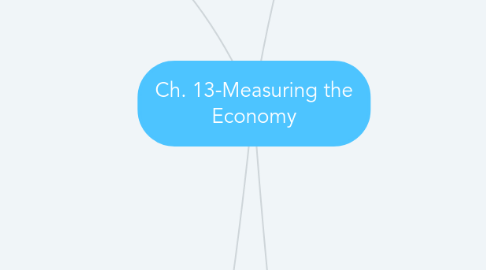
1. 13.2--How Do Economists Measure the Size of an Economy?
1.1. Key Points:
1.1.1. The main measure of the size of a nation's economy is its gross domestic product. GDP is an economic indicator that measures a country's total economic output. A steadily growing GDP is generally considered a sign of economic health.
1.1.2. Economists also use GDP to compare the economies of individual countries. Per capita GDP is a nation's real gross domestic product divided by its population. It is an accepted measure of a society's standard of living.
1.1.3. As a country's per capita GDP increases, so too do other indicators of well-being, like literacy and education, health and life expectancy, and standard of living.
1.1.4. Economists typically calculate GDP by measuring expenditures on goods and services produced in a country. There are four components of GDP: household consumption (C), business investment (I), government purchases (G), and the net of exports minus imports (NX).
1.2. Vocab:
1.2.1. Final good: any new good that is ready for use by a consumer.
1.2.2. Intermediate good: goods that are used in the production of final goods
2. 13.3--What Does the Unemployment Rate Tell Us About an Economy’s Health?
2.1. Key Points:
2.1.1. Like the GDP, the unemployment rate is a useful indicator of the health of an economy. In general, a high unemployment rate means the overall health of the economy is poor.
2.1.2. Some economic costs of a high unemployment rate include lost potential output, the serious economic cost that unemployed people have on the economy, and the high cost on society as a whole.
2.1.3. The problems with using the unemployment rate as an economic health include the fact that a number of unemployed people have given up looking for work, the official unemployment rate does not recognize involuntary part-time workers, and the idea that the unemployment rate involves people working in informal or underground economies.
2.1.4. In terms of classifying people who are employed, members of the labor force who have jobs are classified as employed, members of the labor force who are jobless, but are looking for work, are classified as unemployed, and everyone who is eligible to be in the labor force but is neither working nor looking for work is classified as not in the labor force.
2.2. Vocab:
2.2.1. Frictional unemployment: person has left one job and is looking for another
2.2.2. Structural unemployment: unemployment caused because robots take over jobs previously done by humans
3. 13.4--What Does the Inflation Rate Reveal About an Economy’s Health?
3.1. Key Points:
3.1.1. Some causes of inflation include an increase in the money supply, an increase in overall demand, and increases in the cost of the factors of production.
3.1.2. An inflation of any amount has economic consequences including loss of purchasing power, higher purchasing power, and a loss of efficiency.
3.1.3. Economists track changes in the cost of living using what is known as the consumer price index. The consumer price index (CPI) is a price index for a “market basket” of consumer goods and services.
3.1.4. In the United States we have come to expect a certain amount of gradual inflation, or creeping inflation, every year, but if inflation goes into hyperdrive, it's known as hyperinflation. Also, deflation occurs when prices go down over time.
3.2. Vocab:
3.2.1. Inflation rate: the percentage increase in the average price level of goods and services from one month or year to the next
3.2.2. Nominal cost of living: the cost in current dollars of all the basic goods and services that people need
3.2.3. Real cost of living: the nominal cost of basic goods and services, adjusted for inflation
4. 13.5--How Does the Business Cycle Relate to Economic Health?
4.1. Key Points:
4.1.1. The business cycle consists of four phases: a period of economic growth known as expansion, a point where the growth ends known as a peak, then there's a contraction, and the lowest point of the contraction called a trough.
4.1.2. Business cycles are irregular in both length and severity. This makes peaks and troughs difficult to predict. Nonetheless, economists attempt to do just that, using a variety of economic indicators.
4.1.3. Business cycles are popularly known as periods of boom and bust. A boom is the expansion phase of the cycle. But inevitably, boom turns to bust. The bust, or contract-ion phase of the business cycle, is also called a downturn, a downswing, or a recession.
4.1.4. On rare occasions, a recession will last a long time and cause serious damage to the economy. Economists refer to this kind of severe contraction as a depression.
4.2. Vocab:
4.2.1. Inventory: merchandise that companies or stores have on hand
4.2.2. Leading economic indicators: measures that consistently rise or fall several months before an expansion or a contraction begins
4.2.3. Lagging economic indicators: measures that consistently rise or fall several months after an expansion or a contraction
